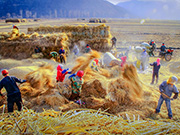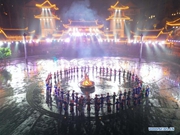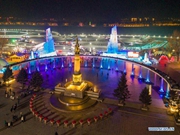

Gama Deleg teaches thangka painting to his apprentices at a training base of ethnic handicrafts making in Kabma Township of Qamdo, southwest China's Tibet Autonomous Region, Oct. 3, 2020.
In recent years, Tibet has made great efforts to develop modern vocational education. A training base of ethnic handicrafts making was set up in Kabma Township by the 88-year-old Gama Deleg, an inheritor of the intangible cultural heritage Karma Gardri, which is a genre of thangka painting. At present, a total of 460 apprentices study thangka painting here.
The base upgraded the production mode of traditional handicrafts and advanced poverty alleviation. With a per capita income of about 200,000 yuan (about 30,217 U.S. dollars) last year, 112 apprentices have helped their families shake off poverty by the craft of painting thangka.
Thangka is a form of Tibetan Buddhist scroll painting on cotton or silk, with mineral and organic pigments derived from coral, agate, sapphire, pearl, and gold. The paintings typically depict Buddhist deities with colors that can remain intact for centuries. (Xinhua/Jigme Dorje)
 |

 Award-winning photos show poverty reduction achievements in NE China's Jilin province
Award-winning photos show poverty reduction achievements in NE China's Jilin province People dance to greet advent of New Year in Ameiqituo Town, Guizhou
People dance to greet advent of New Year in Ameiqituo Town, Guizhou Fire brigade in Shanghai holds group wedding
Fire brigade in Shanghai holds group wedding Tourists enjoy ice sculptures in Datan Town, north China
Tourists enjoy ice sculptures in Datan Town, north China Sunset scenery of Dayan Pagoda in Xi'an
Sunset scenery of Dayan Pagoda in Xi'an Tourists have fun at scenic spot in Nanlong Town, NW China
Tourists have fun at scenic spot in Nanlong Town, NW China Harbin attracts tourists by making best use of ice in winter
Harbin attracts tourists by making best use of ice in winter In pics: FIS Alpine Ski Women's World Cup Slalom
In pics: FIS Alpine Ski Women's World Cup Slalom Black-necked cranes rest at reservoir in Lhunzhub County, Lhasa
Black-necked cranes rest at reservoir in Lhunzhub County, Lhasa China's FAST telescope will be available to foreign scientists in April
China's FAST telescope will be available to foreign scientists in April